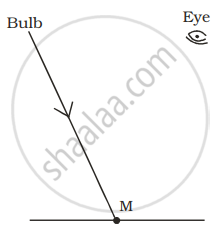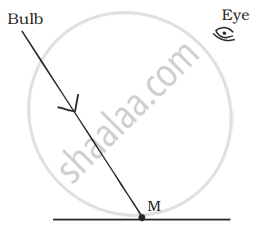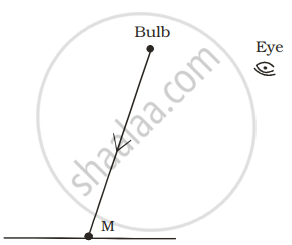Advertisements
Advertisements
प्रश्न
Write the function of the human eye and label parts of the figure given below.

उत्तर
- Double convex transparent crystalline lens: It provides small adjustments of the focal length to focus the image. This lens creates a real and inverted image of an object on the screen inside the eye.
- Optic nerve: The sensitive cells on the retina get excited when light falls on them and generate electric signals. The optic nerve carries these signals to the brain.
- Retina: It is the screen inside the human eye which contains light-sensitive cells. Image of an object is formed on this screen.
- Pupil: The pupil contracts or widens depending on the intensity of light incident on the eye.
APPEARS IN
संबंधित प्रश्न
Write the function of the following part of the human eye:- iris
Write the function of the following part of the human eye: ciliary muscles
Describe the anatomy of the human eye.
Name that part of the eye which is equivalent to the photographic film in a camera.
What is the:
far point of a normal human eye?
What is the:
near point of a normal human eye?
What is the range of vision of a normal human eye?
Give the scientific names of the following parts of the eye:
carries signals from an eye to the brain.
Give the scientific names of the following parts of the eye:
changes shape to focus a picture on the retina.
How is the amount of light entering the eye controlled?
Name two animals having eyes:
at the front of the head.
The animals of prey have:
(a) two eyes at the front
(b) two eyes at the back
(c) two eyes on the sides
(d) one eye at the front and one on the side
The animals called predators have:
(a) both the eyes on the sides
(b) one eye on the side and one at the front
(c) one eye on the front and one at the back
(d) both the eyes at the front
Name the following:
The part of the eye responsible for its shape.
The figure below compares a part of our eye with a part of a photographic camera.

Name the corresponding parts of the eye the camera shown here that are comparable in function.
Give the main function of the following:
Retina
Choose the correct answer.
Which one is the photoreceptor _____________
What is meant by power of accommodation of the eye?
Name the following:
The focal length of the lens is altered by the contraction of which type of muscles.
Name the following:
Yellow spot and ciliary muscles are found in.
State the Function:
Visual purple
State the Function:
Vitreous humour
Choose the Odd One Out:
Complete the following sentence with appropriate Word
The part of the human eye where rod cells and cone cells are located is the:
For the normal human eye, the near point is at ___________ cm.
Vision defect that increases distance between the lens of the eye and retina of the eye is termed as myopia.
Write an Explanation.
Farthest distance of distinct vision
In a myopic eye, the image of the object is formed
At noon the sun appears white as
From where the following nerves arise.
Optic nerve
A tiny mirror M is fixed on a piece of cardboard placed on a table. The cardboard is illuminated by light from a bulb. The position of eye with respect to position of bulb is shown in the figure as A, B, C and D. In which position mirror will be visible?
 |
 |
 |
 |
| (A) | (B) | (C) | (D) |
Which of the following statements is correct regarding rods and cones in the human eye?
Boojho while waving his hand very fast in front of his eyes, observes that his fingers appear blurred. What could be the reason for it?
Match the following:
| Column - I | Column - II | ||
| 1 | Retina | a | pathway of light |
| 2 | Pupil | b |
far point comes closer |
| 3 | Ciliary muscles | c |
near point moves away |
| 4 | Myopia | d | screen of the eye |
| 5 | Hypermetropia | e | power of accommodation |
Arrange and rewrite the term in group in correct order to be in a logical sequence, beginning with the term that is underlined:
Pupil, Aqueous humour, Retina, Vitreous humour.
Match the following.
| Column - I | Column - II | ||
| 1 | Retina | a | Path way of light |
| 2 | Pupil | b | Far point comes closer |
| 3 | Ciliary muscles | c | near point moves away |
| 4 | Myopia | d | screen of the eye |
| 5 | Hypermetropia | e | Power of accomadation |
State the functions of the following:
Iris
Name the following:
Three layers of the eye ball.
Give reason:
Blind spot is considered as 'area of no vision'.
